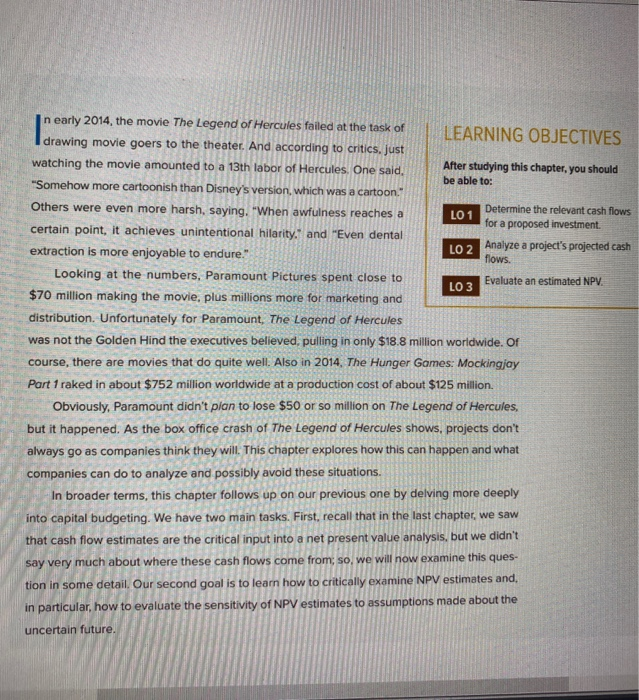nearly 2014, the movie The Legend of Hercules failed at the task of LEARNING OBJECTIVES drawing movie goers to the theater. And according to critics, just watching the movie amounted to a 13th labor of Hercules. One said. After studying this chapter, you should be able to: "Somehow more cartoonish than Disney's version, which was a cartoon." Others were even more harsh, saying, "When awfulness reaches a LO1 Determine the relevant cash flows for a proposed investment. certain point, it achieves unintentional hilarity." and "Even dental LO 2 Analyze a project's projected cash extraction is more enjoyable to endure." flows. Looking at the numbers, Paramount Pictures spent close to LO 3 Evaluate an estimated NPV. $70 million making the movie, plus millions more for marketing and distribution. Unfortunately for Paramount, The Legend of Hercules was not the Golden Hind the executives believed, pulling in only $18.8 million worldwide. Of course, there are movies that do quite well. Also in 2014, The Hunger Games: Mockingjay Part 1 raked in about $752 million worldwide at a production cost of about $125 million Obviously, Paramount didn't plan to lose $50 or so million on The Legend of Hercules, but it happened. As the box office crash of The Legend of Hercules shows, projects don't always go as companies think they will. This chapter explores how this can happen and what companies can do to analyze and possibly avoid these situations. In broader terms, this chapter follows up on our previous one by delving more deeply into capital budgeting. We have two main tasks. First, recall that in the last chapter, we saw that cash flow estimates are the critical input into a net present value analysis, but we didn't say very much about where these cash flows come from; so, we will now examine this ques- tion in some detail. Our second goal is to learn how to critically examine NPV estimates and, in particular, how to evaluate the sensitivity of NPV estimates to assumptions made about the uncertain future. nearly 2014, the movie The Legend of Hercules failed at the task of LEARNING OBJECTIVES drawing movie goers to the theater. And according to critics, just watching the movie amounted to a 13th labor of Hercules. One said. After studying this chapter, you should be able to: "Somehow more cartoonish than Disney's version, which was a cartoon." Others were even more harsh, saying, "When awfulness reaches a LO1 Determine the relevant cash flows for a proposed investment. certain point, it achieves unintentional hilarity." and "Even dental LO 2 Analyze a project's projected cash extraction is more enjoyable to endure." flows. Looking at the numbers, Paramount Pictures spent close to LO 3 Evaluate an estimated NPV. $70 million making the movie, plus millions more for marketing and distribution. Unfortunately for Paramount, The Legend of Hercules was not the Golden Hind the executives believed, pulling in only $18.8 million worldwide. Of course, there are movies that do quite well. Also in 2014, The Hunger Games: Mockingjay Part 1 raked in about $752 million worldwide at a production cost of about $125 million Obviously, Paramount didn't plan to lose $50 or so million on The Legend of Hercules, but it happened. As the box office crash of The Legend of Hercules shows, projects don't always go as companies think they will. This chapter explores how this can happen and what companies can do to analyze and possibly avoid these situations. In broader terms, this chapter follows up on our previous one by delving more deeply into capital budgeting. We have two main tasks. First, recall that in the last chapter, we saw that cash flow estimates are the critical input into a net present value analysis, but we didn't say very much about where these cash flows come from; so, we will now examine this ques- tion in some detail. Our second goal is to learn how to critically examine NPV estimates and, in particular, how to evaluate the sensitivity of NPV estimates to assumptions made about the uncertain future







